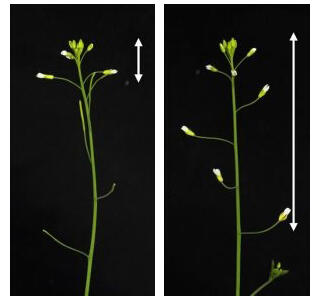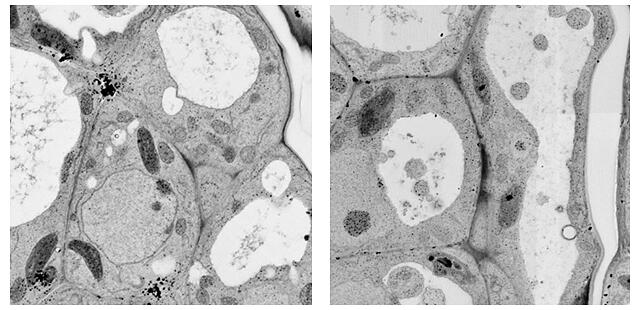"Cherry Blossoms, on this calm, lambent day of spring, why do you scatter with such unquiet hearts?"
A waka poem by Ki no Tomonori, a Heian period poet. It is included in the Kokin Wakashū (Collection of Japanese Poems of Ancient and Modern Times) and is well known as a poem in the Ogura Hyakunin Isshu (One Hundred Poets, One Poem Each). This poem means "Why do cherry blossoms fall with unquiet hearts on a spring day when the sun is shining so peacefully?" The answer to this question came in 2024. "Because autophagy is at work." Autophagy is a mechanism by which cells break down intracellular waste by themselves and is well known in Japan as a Japanese scientist was awarded the Nobel Prize for their research on it. A group of researchers from the Nara Institute of Science and Technology, RIKEN, and other institutions has revealed that this also plays a key role in the mechanism of abscission of flower petals.

Photo taken by the author at Chidorigafuchi, Tokyo in April 2005
Important cellular maintenance function
Autophagy is a mechanism by which cells break down old intracellular proteins and organelles by themselves (autophagocytosis) and reuse the components. It is found in eukaryotic cells, purifies the cell interior, and makes necessary molecules such as amino acids for the maintenance of life. It is one of the key cellular maintenance functions that are essential for plants and animals to remain healthy. Waste is not broken down haphazardly over time, cells instead are actively breaking it down. In Greek, auto (autó) means self and phagy (phagein) means eating. Dr. Yoshinori Osumi, an Honorary Professor of Tokyo Institute of Technology, succeeded in observing autophagy in yeast in 1988. He identified 14 related genes in 1993 and was awarded the Nobel Prize in Physiology or Medicine in 2016.
In autophagy in animals, "autophagosomes," vesicles made of double-layer membranes, are formed inside the cells to take up old proteins and other substances. They fuse with "lysosomes," a type of organelle containing enzymes, and the contents are broken down. Autophagy suppresses various diseases, including cancer and neurodegenerative diseases, and plays important roles in development, differentiation, senescence, and immune mechanisms. However, in plants, autophagosomes fuse with "vacuoles" that store water, nutrients, and waste products, and the contents are then degraded.
Autophagy is very important in plants as they continue to build the body throughout life. Cereals and flowering plants (plants that bear flowers) are known to have a very large number of genes regulating autophagy. It has also been observed that cell organelles and other structures are incorporated into the vacuoles and partially decomposed during aging of flower petals. Autophagy had been presumed to be involved in abscission of petals, however, its involvement had yet to be clarified.
Many studies on flowering... but this time petal abscission
With this in mind, Associate Professor Nobutoshi Yamaguchi, who studies plant physiology at the Graduate School of Science and Technology at Nara Institute of Science and Technology, and his research group, conducted a study on Arabidopsis thaliana, a model plant commonly used in experiments. He commented, "Don't you wonder why cherry blossoms fall? I started this research project to figure out the basis of this phenomenon." Researchers in advanced fields gain motivation by wondering "I know the phenomenon, but how and why on earth does it happen?" Though there have been many studies on flowering, what happens after that has not been studied as much.
"Jasmonic acid," a plant hormone, attracted his attention. It is an interesting substance in that it is synthesized when a leaf is eaten by insects and translocated to other parts of the plant where it promotes the production of substances that insects don't like for preventing the spread of damage. Jasmonic acid is also described in high school biology textbooks. It also has the ability to promote senescence. As petal abscission was delayed in mutants incapable of producing jasmonic acid, this compound was thought to play a key role.
When ordinary A. thaliana was examined, jasmonic acid and reactive oxygen species, which are "senescence substances" that oxidize and damage other substances, accumulated at the bases of petals just before abscission. However, in the mutant incapable of producing jasmonic acid, the acid did not accumulate at the bases of petals, and reactive oxygen species were also accumulated markedly less.
Cells at the bases of petals were observed under a microscope. In ordinary A. thaliana, waste was entirely decomposed just before petal abscission, leaving nothing in the vacuole. However, the mutant had waste in the vacuole, indicating abnormal metabolism. The results suggest that autophagy was at work in the process of petal abscission in normal plants.

Provided by Nara Institute of Science and Technology

Provided by Nara Institute of Science and Technology
"Jasmonic acid" triggers activation of genes one after another...
Next, the team investigated how the related genes work until petal abscission and clarified the following processes: (1) when the flowers bloom, jasmonic acid is produced and accumulates in the petals; (2) the "ANAC102 gene," which is implicated in stress response, is activated at the petal base; and (3) the genes that control autophagy are activated, resulting in petal abscission.
Moreover, petal abscission was delayed in mutants of the genes that regulate autophagy. The research group also succeeded in artificial expression of the gene at the petal base to induce autophagy and petal abscission.
They compared normal A. thaliana to a mutant in which jasmonic acid does not work. The protein produced from a gene involved in autophagosomes was fused to green fluorescent protein (GFP) as a marker. In normal plants, autophagosomes were produced when the time of petal abscission approached, as indicated by increased GFP fluorescence. Then, just before petal abscission, the autophagosomes moved into the vacuoles, degraded with the contents, and fluorescence was no longer detected. In contrast, in the mutant, fluorescence remained detectable even after the time supposed to be just before petal abscission. Autophagosomes were accumulating, indicating that autophagy was not occurring.

Provided by Nara Institute of Science and Technology University
A series of results revealed that petal abscission is promoted by the mechanism of jasmonic acid-induced autophagy. The research group includes researchers from Nara Institute of Science and Technology, RIKEN, Trinity College Dublin (Ireland), Kazusa DNA Research Institute, Nagoya University, and Chubu University. The results were published in the British scientific journal Nature Communications on February 6 and announced by Nara Institute of Science and Technology University on February 8.
The path to achievements that will please both florists and customers
However, even with these results, a simple question remains. It is believed that the flowers bloom to attract insects for pollination. Then, why do plants take the trouble to promote abscission of flowers through autophagy? Can't they just leave their flowers there? When I asked Yamaguchi, he kindly shared his thoughts, "I don't know for sure... but I think it's because if plants don't cut off the parts they don't need anymore, the (extra) nutrients will be taken up by those parts. The flowers are probably falling off after the nutrients are collected, and sugars and other nutrients are sent to other parts of the body."
Although the mechanism clarified here was studied in A. thaliana, he believes that many flowers depend on a similar mechanism of petal abscission. Yamaguchi spoke about the future directions of his research, "We would like to study the mechanisms in other plants. Furthermore, if we can confirm that plants actually collect nutrients in the manner I described before, we will have a better understanding of why flowers fall."
This achievement, which solved a simple question in nature, not only satisfied our intellectual curiosity but is also likely to be useful in the agricultural and horticultural fields in the future. For example, if we can slow down autophagy to delay flower fall, it would help florists in areas far from where flowers are grown. Customers will also be happy because they can enjoy the flowers for a long time after they buy them. This approach will also find application in crop production, for example, to adjust harvesting times for improved efficiency.
The Japanese have used natural scenes as the subject of countless literary works, but those works may be enjoyed in a different way through the eyes of modern science. The cherry blossom viewing season has just come to an end. In the future, we may recall the results of this research and think about autophagy while viewing the cherry blossoms. However, whether it makes the alcohol and food more tasty or worse... I cannot be held responsible for that.

(KUSAKA Takeo / Science Portal Editorial Office)
Original article was provided by the Science Portal and has been translated by Science Japan.




